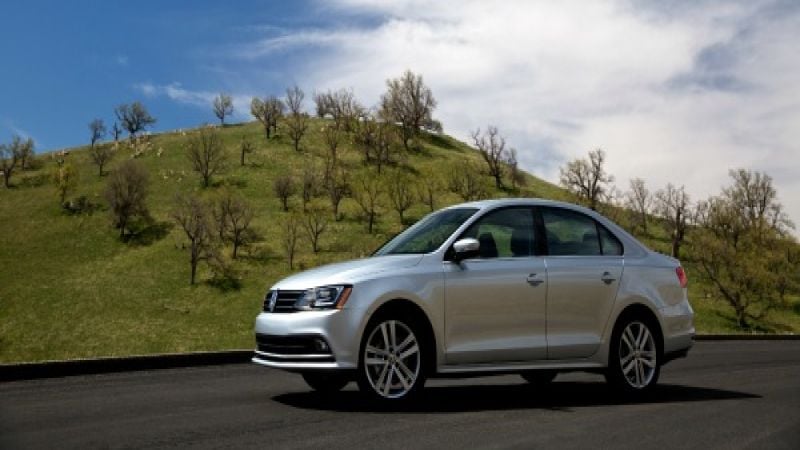The 2015 Volkswagen Jetta sedan has gotten a bit of a facelift, and will be making its world debut at the 2014 New York International Auto Show.
The Jetta has been Volkswagen of America’s top-selling vehicle for decades, and one of the world’s most successful sedans, having sold more than 14 million since 1979. But, the 2015 model has notable changes throughout, Volkswagen has indicated, with overall efficiency improved by reducing air drag and improving rolling resistance with new tires. Consumers can still choose one of three four-cylinder gasoline engines; a 1.4-liter turbocharged full hybrid version; or a new 150-horsepower, EA288 2.0L TDI Clean Diesel engine (which VW estimates will get 32 city/45 highway mpg, manual transmission).
Safety Takes the Front Seat
Volkswagen is stressing that the 2015 Jetta has been engineered to meet or exceed all current U.S. safety standards. With safety in mind, those considering the new Jetta will no doubt be pleased to learn of the new driver assistance systems that will be available to consumers, including Blind Spot Detection, frontal collision warning, and rear cross-traffic alert. These features will definitely be of interest to families, but should be welcomed additions for any Jetta owner. After all, we all want to drive safely, for our own sakes and for the health and safety of those riding with us and existing around us, right? These features will improve driver awareness, and hopefully decrease the chance of collision, in the following ways:
- Blind Spot Detection: Blind Spot Detection utilizes a flashing symbol in the outer area of the side mirrors to make the driver aware of vehicles in the blind spot next to the Jetta or approaching from the rear. This is intended to help improve driver awareness when changing lanes. The system uses radar sensors to "monitor" a space around the vehicle with a range of approximately 65 feet. Customers who choose the Blind Spot Detection option automatically get the rear cross-traffic alert assistance system as well.
- Rear cross-traffic alert: The new rear cross-traffic alert assistance system is offered in tandem with Blind Spot Detection. The system not only helps alert the driver to stationary and moving vehicles directly behind the vehicle, it also detects vehicles approaching from the side which may be difficult for the driver to see. The radar-based sensor module can even detect objects up to 65 feet away. In case of an impending collision, the system gives an acoustic warning.
- Frontal collision warning: The frontal collision warning system uses radar sensors to continually monitor the distance to traffic ahead of the vehicle. Within physical system limits, frontal collision warning warns the driver of critical front-end collision situations, both acoustically and visually by a clear warning symbol in the instrument cluster. The radar sensor acquires both the position of stationary cars and motorcycles and those moving in the same direction as the vehicle. The sensor is hidden behind the VW logo on the radiator grille.
Improving AeroDynamics in 2015
Volkswagen has also redesigned the front and rear of the Jetta. While none of the new features are necessarily explosively eye-catching, Volkswagen says that the changes have improved aerodynamic properties. The new bumper reduces air drag, the company says, as do the optimized air intakes and aerodynamically refined rain gutters on the sides near the A-pillars. Other aerodynamic modifications include underbody panels at the rear axle and sill covers with wheel spoilers; modified brake ventilation channels for Jetta models equipped with the 1.8T engine; and special aerodynamic elements such as new front/rear spoilers and sill extensions for the Jetta GLI and Jetta Hybrid models.
Additionally, the dynamic radiator shutter on the Jetta TDI 1.8T and 2.0 TDI Clean Diesel closes the radiator shutter to shorten the warm-up phase. When closed, frontal airflow is guided around the body, which helps to improve the car's aerodynamics and thus reduces fuel consumption. Once the engine moves beyond the warm-up phase, the shutter can open and close based on vehicle speed and cooling demands.
The Interior Gets a Boost
Those wondering about the interior will be glad to know that Volkswagen has brought attention to detail inside, as well. On mid- and high-level trims, the dash gauges can now framed in chrome-edged tubes, with an available color multifunction display nestled in between. Also, the Jetta will also offer several optional new features, including a new multifunction steering wheel; redesigned air vent controls; piano black accents on the center console and around the gear shift lever; new chrome accents around the dual-zone Climatronic control; ambient lighting; and new fabric colors and designs for the seats. Again, nothing explosively eye-catching, but options for change, nevertheless.
The 2015 Volkswagen Jetta is expected to arrive at U.S. Volkswagen dealers in the third quarter of 2014.










